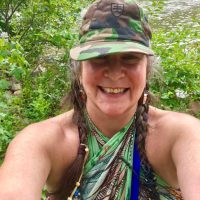
*Editor’s Note: This piece is part of a series—lucky you! Follow Geri to get notified when the next article is available to read. And check out Part One here.
~
We had been hoping to spot a bald eagle since moving to Tennessee four and a half years ago, and last week we experienced two sightings right over the creek in our forest.
What brought them here? Why now?
This is the coldest winter we’ve had since relocating here. Temps were negative two degrees over the Christmas weekend. Has the colder weather encouraged nesting nearby?
There aren’t many fish in the creek sizable enough to maintain them on a steady diet, however, there’s plenty of game for them to hunt. Bald eagles are known to travel 300-500 miles in a day.
We also noticed a red-headed woodpecker frequenting the trees. It’s always a treat to see them or the pileated woodpeckers with their Woody Woodpecker laugh visiting the forest.
We even recently spotted an otter couple in the creek floating downstream searching for mussels. This was truly a rare sighting for us! It’s happened maybe three times over the years.
This month has been a gift of wildlife sightings that have made us giggle with the wonder of children since we rarely get to spot some of these species out in the open. We know they co-exist with us here—they just don’t make themselves visible to humans.
A wonderful sign of the local deer population growth was the recent herd of four deer together at the same time in our area. This was such a hopeful indication that maybe the Hemorrhagic Disease, sometimes referred to as Black Tongue Disease, which has plagued the local white-tailed deer population is ending and the herds are recovering. Since we live in a town called Deer Lodge, we’ve grieved the dwindling numbers.
During the COVID-19 lockdowns, when people were isolated and the streets were quiet, there were reports of more wildlife roaming about as vast numbers of workers stayed home and worked remotely. The air quality improved as less cars were on the roads and people detected more creatures roaming about their neighborhoods that typically stay hidden from humans. By now, most of us understand the climate emergency is human-created. With all the world news about species extinction, there are still signs out there of habitat restoration and how it can affect the other beings we share this planet with. It didn’t take long to see some visible changes during the isolation periods, so there is hope we can make changes—if we choose.
Living far from the city enables us to engage with the other beings we share this land with and makes us consider how our actions may affect them. (I’ll share more about this in Part Three of this series.)
Upon reflection, the signs we observed with the wildlife, water, and resources I wrote about in Part One of this series revealed that our area in California was heading for a crisis. I believe in following the signs, and we can find them just by spending time outside or by looking out our windows at that pure moment of synchronicity. We simply need be to present enough to notice all the abundance surrounding us.
More action items we can take to notice and support our environments:
>> Plant a pollinator garden to support the bees, butterflies, hummingbirds, and others. (Hint: If you plant your pollinators near your veggie garden, they’ll mosey over to pollinate your veggies.)
>> Put out water for the local wildlife, particularly during wildfires and warmer seasons.
>> Any day is a good way to plant a tree for the local habitat!
>> If you live in a city near dining and entertainment, walk or ride your bike. It’s fun with a group of friends or on a date.
>> Continue to work remotely if possible or negotiate that in lieu of pay disparities.
>> Bird feeders are a great way to get to know the habits and schedules of the local feathered friends as an entertaining pastime.
>> If you live near a body of water, it’s fun to sit and be present to see what wildlife shows up to join you there. Sometimes it feels like being in a Disney movie.
What are other ways we can live in reciprocity with our local wildlife? In most scenarios, they were on the land before we moved onto it, so we need to stop treating them like they are the intruders.
May we take time to enjoy the gifts that exist in our environments as we deepen into our season of wintering. Blessings to all!
~
Please consider Boosting our authors’ articles in their first week to help them win Elephant’s Ecosystem so they can get paid and write more.
~











Read 8 comments and reply